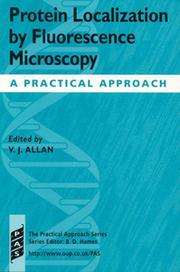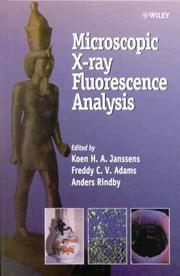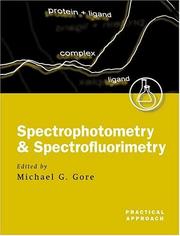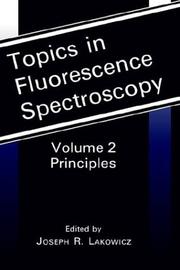| Listing 1 - 10 of 11 | << page >> |
Sort by
|
Book
Year: 2000 Publisher: Bruxelles: UCL.,
Abstract | Keywords | Export | Availability | Bookmark
 Loading...
Loading...Choose an application
- Reference Manager
- EndNote
- RefWorks (Direct export to RefWorks)
A technique was developed for the determination if arsenite (AsIII), arsenate (AsV), monomethylarsonic acid (MMA) and dimethylarsinic acid (DMA) in human urine by high performance liquid chromatography coupled with hydride generation and atomic fluorescence detection. The separation efficiency by anion exchange column (PRP-X100) was studied. Effects such as argon and hydrogen flow rates, hydrochloric acid and sodium borohydride concentrations were assessed by determination of the signal to base ratio. Arsenobetaïne (AB), arsenocholine (AC) and trimethylarsine (TMA) were detected only after oxidation. This method displays a large range of linearity and 0.3 ng, 0.4 ng, 0.4 ng and 0.8 ng are the detection limits for AsIII, MMA, DMA, AsV respectively. A comparison between atomic fluorescence spectroscopy and atomic absorbance spectroscopy was made by analyzing sample of two rounds of an external quality testing program. Nous avons développé une technique permettant la détermination dans l’eau et dans l’urine de l’arsénite (AsIII), de l’arsénate (AsV), de l’acide monométhylarsonique (M.M.A.) et de l’acide diméthylarsinique (D.M.A.), par chromatographie liquide à haute performance couplée à un générateur d’hydrure et à un détecteur de fluorescence atomique. Nous avons étudié l’efficacité de la séparation des diverses formes de l’élément sur une colonne échangeuse d’anions (PRP X-100). Nous avons optimisé les paramètres de détection, tels que les débits d’hydrogène et d’argon, les concentrations en acide chlorhydrique et en borohydrure sodique, par calcul du rapport signal/bruit. L’arsénobétaïne (AB) , l’arsénocholine (AC) et l’oxude de triméthylarsine ne sont détectables que s’ils ont été préalablement oxydés. Cette méthode possède une linéarité de réponse sur plusieurs ordres de grandeurs et les limites de détection sont respectivement pour AsIII, MMA, DA, AsV de 0.3 ng, 0.4 ng, 0.4 ng et 0.8 ng. Nous avons comparé, pour des échantillons de routine, les résultats de dosages par fluorescence atomique et absorption atomique.
Chromatography, Liquid --- Fluorescence --- Arsenic --- Water Pollutants, Chemical

ISBN: 0199637407 0199637415 Year: 2000 Volume: 218 Publisher: Oxford [etc.] : Oxford University Press,
Abstract | Keywords | Export | Availability | Bookmark
 Loading...
Loading...Choose an application
- Reference Manager
- EndNote
- RefWorks (Direct export to RefWorks)
Proteins --- Fluorescence microscopy. --- Green fluorescent protein. --- Immunofluorescence. --- Protéines --- Microscopie de fluorescence --- Protéine fluorescente verte --- Immunofluorescence --- Analysis. --- Analyse --- LABORATORY MANUALS --- FLUORESCENCE MICROSCOPY --- PROTEINS --- HANDBOOKS --- LOCALIZATION
Book
ISBN: 9786610375684 128037568X 0191565911 0585483396 9780585483399 9781280375682 9780191565915 6610375682 1383049637 Year: 2000 Volume: 218 Publisher: Oxford New York Oxford University Press
Abstract | Keywords | Export | Availability | Bookmark
 Loading...
Loading...Choose an application
- Reference Manager
- EndNote
- RefWorks (Direct export to RefWorks)
An ever-increasing number of genes have been sequenced but are of unknown function. The ability to determine the location of gene products within the cell is a vital step towards understanding them. This guide provides practical advice.
Proteins --- Fluorescence microscopy. --- Microscopy --- Analysis. --- Green fluorescent protein. --- Immunofluorescence.
Dissertation
Abstract | Keywords | Export | Availability | Bookmark
 Loading...
Loading...Choose an application
- Reference Manager
- EndNote
- RefWorks (Direct export to RefWorks)
Aneuploidy --- In Situ Hybridization, Fluorescence --- Micronucleus Tests --- methods

ISBN: 0471974269 Year: 2000 Publisher: Chichester Wiley
Abstract | Keywords | Export | Availability | Bookmark
 Loading...
Loading...Choose an application
- Reference Manager
- EndNote
- RefWorks (Direct export to RefWorks)
Applied chemical analysis --- Spectrometric and optical chemical analysis --- fysicochemie --- X-ray spectroscopy --- Fluorescence spectroscopy --- Spectroscopie de rayons X --- Spectroscopie de fluorescence --- 543.08586 --- Fluorescence spectrometry --- Spectrometry, Fluorescence --- Spectroscopy, Fluorescence --- Luminescence spectroscopy --- Fluorescent probes --- Emission spectroscopy, X-ray --- Energy dispersive x-ray spectroscopy --- Excitation analysis, Fluorescent --- Fluorescence analysis, X-ray --- Fluorescent excitation analysis --- Fluorescent x-ray spectroscopy --- X-ray emission spectroscopy --- X-ray fluorescence analysis --- Spectrum analysis --- Fluorescence spectroscopy. --- X-ray spectroscopy.

ISBN: 0199638128 0199638136 Year: 2000 Publisher: Oxford [etc.] : Oxford University Press,
Abstract | Keywords | Export | Availability | Bookmark
 Loading...
Loading...Choose an application
- Reference Manager
- EndNote
- RefWorks (Direct export to RefWorks)
Analytical chemistry --- spectrofotometrie --- Biochemistry --- Fluorimetry --- Spectrophotometry --- 535.243 --- Fluorescence analysis --- Fluorimetric analysis --- Fluorometric analysis --- Fluorometry --- Luminescence analysis --- Technique --- Astronomical photometry --- SPECTROPHOTOMETRY --- FLUOROMETRY --- OPTICAL ABSORPTION --- FLUORESCENCE --- PHOSPHORESCENCE --- CIRCULAR DICHROISM --- PROTEINS --- DNA --- PROPERTIES
Book
ISBN: 0191918172 9786610757015 1280757019 0191566055 1280375787 9786610375783 0585483493 9780191566059 9780585483498 Year: 2000 Volume: 325 Publisher: Oxford New York Oxford University Press
Abstract | Keywords | Export | Availability | Bookmark
 Loading...
Loading...Choose an application
- Reference Manager
- EndNote
- RefWorks (Direct export to RefWorks)
Optical spectroscopy underpins the day to day operations of most laboratories in the chemical, biological and medical sciences and this edition contains substantially updated and new chapters addressing the principles of most of the more common applications such as: spectrophotometry, spectrophotometric assays, spectrofluorimetry, time resolved fluorescence and phosphorescence studies, circular dichrosim and pre-equilibrium spectroscopic techniques. In all chapters, the emphasis is placed upon the practical aspects, with protocols to guide readers through test experiments.
Spectrophotometry. --- Fluorimetry. --- Biochemistry --- Fluorescence analysis --- Fluorimetric analysis --- Fluorometric analysis --- Fluorometry --- Luminescence analysis --- Analytical chemistry --- Astronomical photometry --- Technique.
Book
ISBN: 9290925647 Year: 2000 Publisher: Noordwijk ESA
Abstract | Keywords | Export | Availability | Bookmark
 Loading...
Loading...Choose an application
- Reference Manager
- EndNote
- RefWorks (Direct export to RefWorks)
X-ray astronomy --- X-ray spectroscopy --- Emission spectroscopy, X-ray --- Energy dispersive x-ray spectroscopy --- Excitation analysis, Fluorescent --- Fluorescence analysis, X-ray --- Fluorescent excitation analysis --- Fluorescent x-ray spectroscopy --- X-ray emission spectroscopy --- X-ray fluorescence analysis --- Spectrum analysis --- Astronomy --- Space astronomy --- X-rays --- XEUS (Spacecraft) --- X-ray Evolving Universe Spectroscopy (Spacecraft) --- XES (X-ray emission spectroscopy)

ISBN: 1280206330 9786610206339 0306470586 0306438755 0306438747 0306439549 0306447843 0306455536 0306464519 0306473879 0387226621 0387233342 0387236449 9786611250546 0387233350 1281250546 1441935541 9786611138127 1281138126 0387276173 0387236473 9780306470592 0306470594 9786610206353 1280206357 0306470608 9786610816491 128081649X 0306471027 9786610206322 1280206322 0306470578 9786610206346 1280206349 9786610206414 1280206411 0306470705 9786610816002 1280816007 0306479478 9780306439544 9780306438752 9780306438745 Year: 2000 Publisher: New York Plenum Press
Abstract | Keywords | Export | Availability | Bookmark
 Loading...
Loading...Choose an application
- Reference Manager
- EndNote
- RefWorks (Direct export to RefWorks)
Topics in Fluorescence Spectroscopy, Advanced Concepts in Fluorescence Sensing Part A: Small Molecule Sensing, is the ninth volume in the popular series Topics in Fluorescence Spectroscopy, edited by Drs. Chris D. Geddes and Joseph R. Lakowicz. This volume incorporates authoritative small molecule analytical fluorescence sensing reviews specialized enough to be attractive to professional researchers, yet also appealing to the wider audience of scientists in related disciplines of fluorescence. Advanced Concepts in Fluorescence Sensing Part A: Small Molecule Sensing is an essential reference for any lab working in the analytical fluorescence sensing field. All academics, bench scientists, and industry professionals wishing to take advantage of the latest and greatest in the continuously emerging field of fluorescence sensing will find it an invaluable resource. Advanced Concepts in Fluorescence Sensing Part A: Small Molecule Sensing topics include: Probes for Anion and Cation Sensing Fluorescent Carbon Dioxide Indicators Fluorescent Redox-Switchable Devices PET based Fluorescence Sensors Oxygen Sensing Fluorescence Sensing using Charge Transfer Probes Fluorescence-based Nitric Oxide Detection About the Editors: Chris D. Geddes is an Associate Professor of Fluorescence Spectroscopy, Director of the Institute of Fluorescence, and Associate Director of the Center for Fluorescence Spectroscopy at the University of Maryland Biotechnology Institute, Medical Biotechnology Center, Baltimore. He is the Editor-in-Chief of the Journal of Fluorescence and both the Editor-in-Chief and Founding Editor of the Who's Who in Fluorescence and Reviews in Fluorescence annual volumes, as well as Executive Director of the Society of Fluorescence. Dr Geddes has published over 100 scientific articles, papers, review articles, books and book chapters on the principles and applications of fluorescence. Joseph R. Lakowicz is Professor of Biochemistry at the University of Maryland School of Medicine, Baltimore and Director of the Center for Fluorescence Spectroscopy. Dr. Lakowicz has published over 400 scientific articles, has edited numerous books, holds 16 issued patents, and is the author of the widely used text, Principles of Fluorescence Spectroscopy.
Diagnostic imaging. --- Electronic books. -- local. --- Fluorescence spectroscopy. --- Lasers -- Diagnostic use. --- Lasers --- Diagnostic use. --- Life sciences. --- Analytical chemistry. --- Biochemistry. --- Life Sciences. --- Biochemistry, general. --- Analytical Chemistry. --- Fluorescence spectroscopy --- Biotechnology. --- Physical chemistry. --- Microscopy. --- Biological Microscopy. --- Physical Chemistry. --- Decay schemes (Radioactivity) --- Radiative transfer. --- Physics. --- General biophysics --- Theoretical spectroscopy. Spectroscopic techniques --- fysicochemie --- Atomic physics --- Analysis, Microscopic --- Light microscopy --- Micrographic analysis --- Microscope and microscopy --- Microscopic analysis --- Optical microscopy --- Optics --- Chemistry, Theoretical --- Physical chemistry --- Theoretical chemistry --- Chemistry --- Chemical engineering --- Genetic engineering --- Analysis, Chemical --- Analytical chemistry --- Chemical analysis --- Metallurgical analysis --- Mineralogy, Determinative --- Biosciences --- Sciences, Life --- Science --- #WSCH:MODS --- Fluorescence spectrometry --- Spectrometry, Fluorescence --- Spectroscopy, Fluorescence --- Luminescence spectroscopy --- Fluorescent probes --- Spectroscopie de fluorescence --- Imagerie pour le diagnostic --- Utilisation diagnostique --- EPUB-LIV-FT SPRINGER-B --- Analytical biochemistry. --- Chemistry, Physical organic. --- Chemistry, Physical organic --- Chemistry, Organic --- Chemistry, Physical and theoretical --- Analytic biochemistry --- Biochemistry --- Chemistry, Analytic --- Biological chemistry --- Chemical composition of organisms --- Organisms --- Physiological chemistry --- Biology --- Medical sciences --- Composition --- Analytic chemistry --- Bioanalytic chemistry --- Bioanalytical chemistry --- Diagnosis --- Clinical imaging --- Imaging, Diagnostic --- Medical diagnostic imaging --- Medical imaging --- Noninvasive medical imaging --- Diagnosis, Noninvasive --- Imaging systems in medicine

ISBN: 3540646019 3642572065 Year: 2000 Publisher: Berlin Springer
Abstract | Keywords | Export | Availability | Bookmark
 Loading...
Loading...Choose an application
- Reference Manager
- EndNote
- RefWorks (Direct export to RefWorks)
New techniques and updated protocols for the detection and analysis of biomolecules - proteins, glycoproteins and nucleic acids - are presented in the second edition of this successful laboratory manual. Highly sensitive systems which are widely used in molecular biological and biomedical laboratories, such as colorimetric, luminescence, fluorescence measuring using antibody/antigen binding or hybridisation, as well as PCR amplification are described in detail. The clearly structured step-by-step protocols with practical hints and a troubleshooting guide are complemented by chapters on the theoretical background and the application of the techniques. Thus the manual will enable scientists to plan, design and conduct the appropriate procedures which fulfill their particular requirements.
Analytical biochemistry --- Acide nucléique --- Nucleic acids --- Protéine --- proteins --- Glycoprotéine --- Glycoproteins --- Biologie moléculaire --- Molecular biology --- Génie génétique --- genetic engineering --- Biomolecules --- Analysis --- Nucleic Acids, Nucleotides, and Nucleosides --- Luminescence --- Photometry --- Amino Acids, Peptides, and Proteins --- Molecular Probes --- Chemistry Techniques, Analytical --- Chemicals and Drugs --- Light --- Laboratory Chemicals --- Investigative Techniques --- Radiation, Nonionizing --- Specialty Uses of Chemicals --- Optical Phenomena --- Radiation --- Chemical Actions and Uses --- Analytical, Diagnostic and Therapeutic Techniques and Equipment --- Physical Phenomena --- Phenomena and Processes --- Electromagnetic Phenomena --- Fluorescence --- Proteins --- Luminescent Measurements --- Nucleic Acid Probes --- Nucleic Acids --- Human Anatomy & Physiology --- Health & Biological Sciences --- Animal Biochemistry --- Fluorescence. --- analysis. --- Cell biology. --- Biochemistry. --- Cell Biology. --- Biochemistry, general. --- Biological chemistry --- Chemical composition of organisms --- Organisms --- Physiological chemistry --- Biology --- Chemistry --- Medical sciences --- Cell biology --- Cellular biology --- Cells --- Composition
| Listing 1 - 10 of 11 | << page >> |
Sort by
|

 Search
Search Feedback
Feedback About UniCat
About UniCat  Help
Help News
News